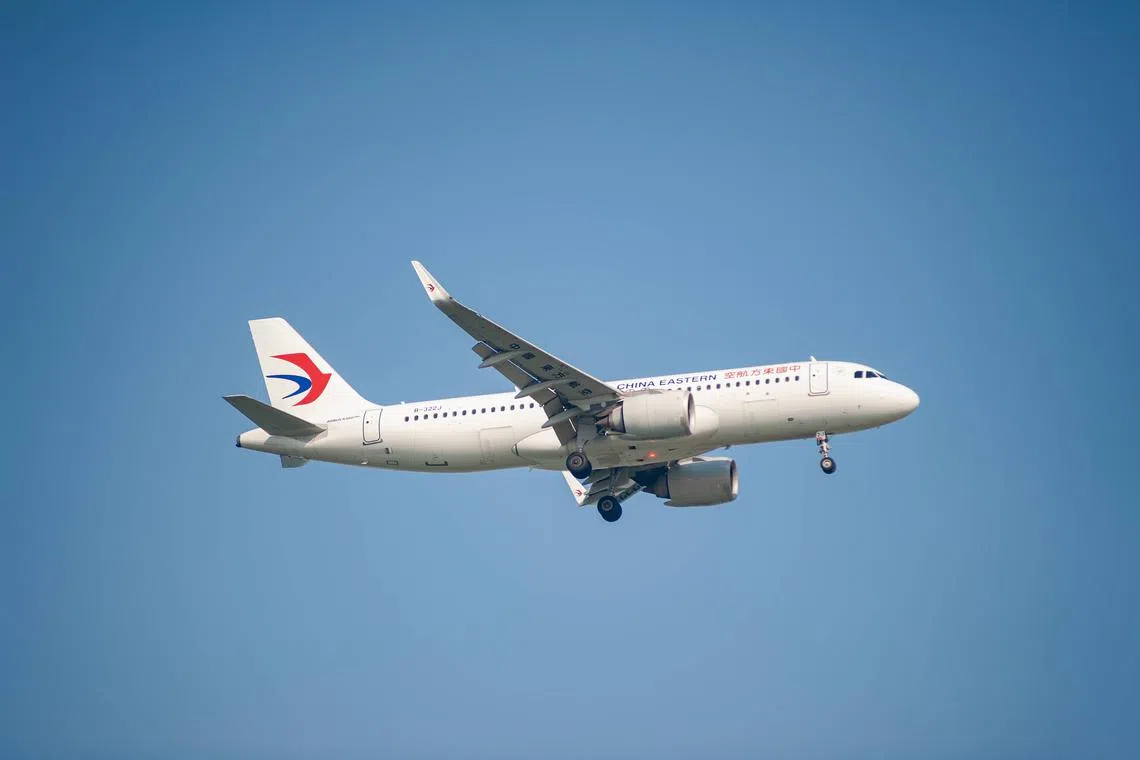What led to Changi Airport runway incident involving 2 China Eastern Airlines planes in Aug 2024
Sign up now: Get ST's newsletters delivered to your inbox

Both aircraft, operated by China Eastern Airlines, had originated from Shanghai Pudong International Airport in China.
PHOTO: REUTERS
Follow topic:
- A runway incursion between two aircraft occurred due to potential miscommunication between flight crew and air traffic control.
- Post-incident, CAAS has enhanced training programmes to improve communication and awareness for air traffic controllers.
- China Eastern Airlines has reminded all its pilots to be vigilant during all phases of flight.
AI generated
SINGAPORE – The failure of pilots aboard a China Eastern Airlines jet to heed an air traffic controller’s instruction to abort its landing and attempt another approach led to a runway incident at Changi Airport in August 2024.
This happened as another plane from the same airline was still leaving the runway area after touching down a minute earlier.
The incident came to light after the Transport Safety Investigation Bureau (TSIB) published an investigation report on Aug 1, 2025.
It was classified as a runway incursion, which is when an unauthorised aircraft, vehicle or person is on or near a runway that is in use.
In this case, the aircraft that landed earlier was not yet clear of the runway strip when the second aircraft touched down.
The runway strip includes the runway and adjacent taxiways, which connect the runway with terminal buildings and other airport facilities.
It also covers stopways on each end of the runway, intended to reduce the risk of damage to aircraft that run off a runway during an aborted take-off, for instance.
Both aircraft originated from Shanghai Pudong International Airport in China.
The first aircraft, an Airbus A320-200neo, landed on Runway 20R at Changi Airport four seconds past 8.12pm on Aug 28, 2024.
Knowing that the first and second aircraft might be in close proximity, the air traffic controller instructed the first aircraft to quicken its exit from the runway, which is 4km long.
The crew on the first aircraft made a left turn towards an adjacent rapid exit taxiway 47 seconds past 8.12pm when its ground speed was about 63kmh, according to TSIB, a department in the Ministry of Transport.
Fifty-four seconds past 8.12pm, the air traffic controller received a visual alert that warned of a runway incursion, suggesting that the first aircraft might not vacate the runway strip in time for the second aircraft to land.
The controller cleared the second aircraft, a Boeing 777-300ER, to land on that runway 55 seconds past 8.12pm, as he assessed that the tail of the first aircraft was already clear of the edge of the runway.
He also assessed that there was no immediate obstruction that would affect the second aircraft’s landing, said TSIB.
The controller also thought that since the first aircraft was still moving, it would vacate the runway strip completely by the time the second aircraft was above the start of the portion of the runway available for landing.
As the first aircraft left the runway for the adjacent taxiway, the pilot continued to apply the brakes to slow the plane further to below 18.5kmh.
The crew later said it had to do so to make a turn exceeding 90 degrees onto another taxiway, according to the airline’s requirements.
The three pilots on the first aircraft had clocked 11,049, 6,439 and 1,092 flying hours.
At 19 seconds past 8.13pm, the air traffic controller instructed the first aircraft to turn left for the other taxiway, when it was still moving along the taxiway adjacent to the runway, noted TSIB.
Shortly after, at 25 seconds past 8.13pm, the controller instructed the second aircraft to go around, as he ascertained that the first aircraft was unlikely to vacate the runway strip in time.
At that point, the second aircraft was about 23.2m above the ground and 296m away from the start of the portion of the runway available for landing.
The crew of the second aircraft did not acknowledge the controller’s instruction and continued with the landing, touching down 38 seconds after 8.13pm.
They later said they were surprised to hear that the controller had told them to go around, and that they had not heard the instruction.
The four pilots on the second aircraft had amassed 20,459, 9,777, 5,783 and 919 flying hours.
There was no injury or damage, and both aircraft subsequently moved to their assigned parking bays.
The investigation team believed the crew on the second aircraft missed the instruction from the air traffic controller.
It was likely that the callouts from the aircraft’s enhanced ground proximity warning system, which announces the plane’s altitude in quick succession as it descends, overlapped with the controller’s go-around instruction.
TSIB added that the crew of the second aircraft were in a phase of their flight that demanded “heightened attention” to ensure a safe landing, which may have affected their ability to hear or respond to the instruction.
For the controller, the bureau found that he had adhered to the procedures set out by the air traffic services provider, the Civil Aviation Authority of Singapore (CAAS), in permitting an aircraft to land when there is “reasonable assurance” it would be kept a safe distance from other planes.
He had eight years and 10 months of experience at the time of the incident.
The controller’s management of the situation also complied with CAAS procedures when he attempted to speed up the movement of the first aircraft to clear the runway strip, in the hopes of preventing the second aircraft from executing an unnecessary go-around.

Mr Michael Daniel, managing director of consultancy Aviation Insight and a member of the International Society of Air Safety Investigators, said missing instructions from air traffic controllers could lead to major accidents, cautioning that this should be avoided.
“When you have aircraft landing and departing from a runway, and other aircraft taxiing on the same runway and its adjacent taxiways, the communications between flight crew and the control tower are very important.”
He added: “It is obvious that you do not want to miss any instructions from either party, or misconstrue any information.”
Mr Daniel said pilots should adhere to the standard operating procedure of looking downwards onto the runway and its adjacent taxiways during landing to prevent and avoid runway incursions.
Following the incident, CAAS told The Straits Times on Aug 15 that it has included lessons from this case in its biannual professional simulator training for air traffic controllers at Changi and Seletar airports to raise awareness and sharpen the skills needed to manage similar situations.
It has also improved its training programmes to include regular scenario-based exercises for controllers to learn how to act and respond during abnormal situations.
CAAS noted that it has also asked its controllers to inform pilots of the reasons for go-around instructions in similar situations, to reduce the likelihood of communication errors.
These revisions have been rolled out across the entire cadre of about 140 controllers who manage air traffic at both airports, including trainees.
TSIB said in its report that China Eastern Airlines has reminded all its pilots to be vigilant during all phases of flight, and to be mindful that controllers may issue a low-altitude go-around instruction during unexpected runway incursions.
The airline did not respond to ST’s request for comment.
While runway incursions are rare


